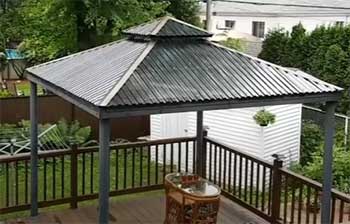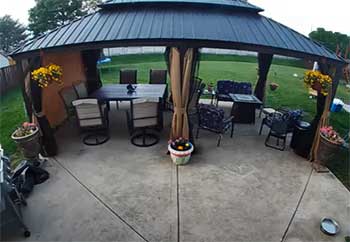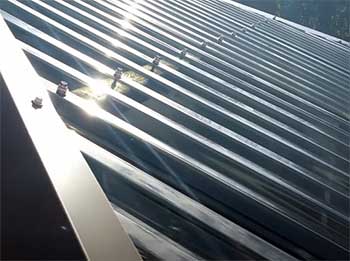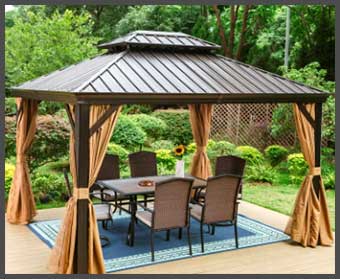If you’re in the market for a new gazebo, one of the biggest decisions you’ll need to make is what material to use for the roof. The roof is arguably the most important component of a gazebo – it needs to stand up to sun, rain, snow and wind while still allowing light to filter through.
The two most popular options for gazebo roofing are polycarbonate panels and galvanized steel. Both have their advantages and disadvantages that are important to weigh when making your choice.
This article will compare and contrast polycarbonate and galvanized steel for gazebo roofs, looking at factors like durability, cost, appearance and maintenance. Read on to learn which option may be the best choice for your new outdoor structure.
A Brief Comparison Table
| Factor | Polycarbonate | Galvanized Steel |
| Long-Term Value | Excellent | Good |
| Durability | 20-30 years | 15-25 years |
| Appearance | Translucent panels, open & airy interior | Opaque panels, enclosed & darkened interior |
| Weather Resistance | Excellent, blocks UV rays & resists hail | Excellent, minor maintenance to prevent rust |
| Installation | Easy for DIY, lightweight panels | Easy for DIY, lightweight panels |
| Maintenance | Nearly zero maintenance needed | Occasional touch up painting & sealing needed |
| Light Transmission | Up to 90% light filtered through | 0% light passed, completely opaque |
| Fire Resistance | Highly fire resistant, chars rather than burns | Non-combustible but may release toxic fumes |
| Wind/Snow Load | Excellent capacity when properly installed | Excellent capacity when properly installed |
| Insulation Value | Good insulation & sound dampening | Poor insulation & sound dampening |
Now that we’ve covered the basics, let’s take a more in-depth look at how polycarbonate and galvanized steel compare for key factors in choosing a gazebo roof material.
Key Differences Between Polycarbonate And Galvanized Steel Gazebo Roofs
- Durability

When it comes to durability, both polycarbonate and galvanized steel rate highly, with some slight differences.
Polycarbonate panels are virtually unbreakable.
They are highly impact resistant, 250 times stronger than glass and resistant to fractures.
Polycarbonate can withstand extreme temperature fluctuations from -40F to 300F as well.
UV-protected polycarbonate resists yellowing and loss of light transmission over time better than other plastics. While not completely scratch-proof, polycarbonate also holds up well to minor abrasions better than other transparent plastics.
Polycarbonate offers excellent durability and longevity, with warrantied lifetimes against breakage, yellowing and hail damage of 10-20 years.
Galvanized steel is also extremely durable. The zinc coating protects the underlying steel from rust, corrosion and degradation. Galvanized steel won’t crack, warp or shatter under pressure. It can last 20-30 years or more.
However, galvanized steel can be prone to minor scratches and dings over time which can expose the steel beneath and eventually lead to rust if not addressed. Touch up paint is required to maintain the protective coating. And the paint finish itself may fade over time requiring refreshing every 5-10 years.
Overall polycarbonate panels may have a slight edge for long-lasting durability and weather resistance requiring less maintenance. But galvanized steel also offers impressive longevity for a gazebo roof with proper occasional minor upkeep.
- Cost

In terms of upfront costs, galvanized steel tends to be more affordable than polycarbonate for gazebo roofing.
Polycarbonate is a premium product that comes at a higher initial price point but offers great value over time.
The cost for polycarbonate panels can range from $5-$7 per square foot installed.
On a 10×12 gazebo, a polycarbonate roof may cost $600-$800.
Polycarbonate is more expensive than other plastic roofing options but comes with higher levels of durability, longevity and performance that offset the price.
Because UV-protected polycarbonate is so resistant to wear and tear over decades, it ends up being very cost effective in the long run.
Galvanized steel roofing panels cost about $1-$3 per square foot. That would make a 10×12 gazebo roof only $120-$300. Steel is less expensive than plastics. And the galvanization zinc coating process adds minimally to the cost.
Being able to buy galvanized steel sheets in standard sizes at home improvement stores keeps costs down as well. Galvanized steel provides excellent value affordably. But lower upfront cost may mean spending a bit more over time on maintenance and earlier replacement.
- Appearance
Polycarbonate and galvanized steel gazebo roofs also differ quite a bit visually:
Polycarbonate allows light to pass through resulting in an open, airy feel. The translucent panels maintain privacy while still letting sunlight filter in. Polycarbonate comes in clear and various subtle tints from bronze to gray.
These understated colors help control glare and heat gain while keeping visibility high both day and night. The sleek, modern look of polycarbonate fits in beautifully in gardens and backyards.
Galvanized steel gazebos have a more closed in, dramatic appearance. The steel panels create a dark, enclosed space that offers a true escape from the exposed outdoors. Opaque steel panels come in a wide range of bold colors from crimson red to cobalt blue that can be coordinated with decor.
But the interior will be quite dark without electricity for lighting. Galvanized steel has an industrial vibe that can lean more to the rustic or modern side depending on paneling style.
When it comes to aesthetics, take into account not just color but the level of light transmission and openness you want for the structure. Polycarbonate offers see-through visibility where galvanized steel encloses fully for very different looks.
- Weather Resistance

Holding up to rain, snow, wind and sun are obviously critical for any gazebo roof material.
Polycarbonate and galvanized steel both deliver excellent all-weather performance.
Polycarbonate is highly impact resistant for protection from hail, falling branches and other debris.
It also withstands high winds very well. Polycarbonate panels won’t warp, bend or crack in extreme heat or cold either.
And the UV-protection means sun exposure won’t cause fogging, discoloration or degradation over time like other plastics. Properly installed polycarbonate roofs are water-tight as the panels form weather-resistant sealed joints.
Condensation and snow build up can be issues to monitor however.
Galvanized steel is also impact, dent and warp resistant for hail and debris protection. Steel can bear heavy snow loads without collapsing or bending. The zinc coating and any additional paint or sealants help prevent corrosion and oxidation from sun.
Minor condensation or mildew may need occasional cleaning. And overtime paint may require touch ups after damage. But overall galvanized steel offers excellent weather-resistance with minimal maintenance needs.
Polycarbonate and galvanized steel both deliver superb durability against outdoor elements making either an ideal gazebo roofing material. Polycarbonate retains its integrity a bit longer before showing age while galvanized steel may require more upkeep for rust prevention as the zinc coating degrades.
- Ease of Installation
Installing a gazebo roof yourself can be a big cost saver versus professional builds. Both polycarbonate and galvanized steel come in standard consumer-friendly sizes that are easy options for DIY gazebo construction.
Polycarbonate panels are lightweight, easily cut to size and mounted with simple hardware like bolts or screws and sealant tape. Polycarbonate manufacturer instructions provide straightforward installation guidance. Roof framing does need to meet standards to properly support the panels.
Gaps may need to be sealed for water tightness. Condensation venting also needs to be addressed. But overall, with basic skills and tools, polycarbonate makes for an achievable DIY gazebo project.
Similarly, galvanized steel panels are lightweight and simple to work with using basic tools. Steel sheets can be cut onsite to accommodate any gazebo size or shape. Panels attach to rafters using self-tapping screws. Overlapping panel seams are sealed using caulk for water protection.
As with polycarbonate, proper roof framing is key to support steel panels. If drainage and ventilation aren’t address, standing water or condensation could cause corrosion over time. But galvanized steel sheets are definitely a doable material for DIYers to install themselves.
Both polycarbonate and galvanized steel gazebo roofs come in easy-to-handle prefabricated panels that can be installed by non-professionals. Following manufacturer instructions for proper framing, ventilation and sealing during installation will optimize durability for either material.
Watch this time-lapse video of its installation.
- Maintenance Needs
Low maintenance is an important factor for gazebo roofs which will largely be left alone once installed. Polycarbonate requires very minimal upkeep compared to galvanized steel.
Polycarbonate panels are virtually maintenance free other than occasional cleaning. Their durability against weathering, yellowing, impacts make them extremely resistant to wear.
Polycarbonate roofs may never even need to be replaced for 20 years or more. At most, some minor sealing of panel connections may be needed over time.
Galvanized steel requires a bit more regular maintenance and care. While the zinc coating provides excellent corrosion resistance, it can wear off over years of exposure. Small scratches or dings in the protective coating need to be immediately touched up with zinc-rich paint to avoid rust formation.
Every 5-10 years, repainting the entire galvanized roof may be needed as the original finish fades or chalks. Ensuring panels and seams are properly sealed is important to prevent water ingress and corrosion as well.
A galvanized steel gazebo roof will last decades but needs periodic minor patching and paint refreshing to maintain its integrity and appearance.
So polycarbonate offers nearly zero maintenance demands once installed. Galvanized steel is also low maintenance but does need minor touch up work on the protective finish every handful of years to extend its lifespan. Both offer durable longevity but polycarbonate’s hassle-free performance gives it an advantage.
- Light Transmission

If maintaining a bright, open interior is a priority for your gazebo space, this is where polycarbonate clearly outshines galvanized steel.
Polycarbonate allows up to 90% of visible sunlight to pass through, avoiding the cave-like effect solid roofing materials create.
Even translucent tinted polycarbonate maintains excellent light transmission.
This allows plants to thrive and provides a bright interior space conducive to activities like outdoor dining. The openness and visibility polycarbonate offers is a major perk.
Galvanized steel panels are entirely opaque. This blocks glare and provides shade but also casts the interior in darkness. Separate lighting systems would need to be integrated to illuminate a steel gazebo at night or on cloudy days.
For fixating light through the roof itself, polycarbonate is the obvious choice.
So in terms of lighting ambiance, polycarbonate filters sunlight beautifully while galvanized steel completely cuts off natural light transmission. Consider how a darker interior may impact your gazebo uses before choosing steel roofing.
- Fire Resistance
An important safety consideration for any structure is fire rating. Polycarbonate and galvanized steel provide differing levels of fire protection.
Polycarbonate is highly fire resistant with a UL94 V-0 rating, the highest standard for flammability. Polycarbonate won’t ignite from small flames or even intensive heat.
To reach combustion temperatures requires over 850 F degrees sustained heat. Under fire conditions, polycarbonate panels char rather than release toxic fumes. This fire resistance makes polycarbonate gazebos quite safe.
Galvanized steel is non-combustible and won’t actually burn or feed a fire. But at high temperatures, the protective zinc coating will off-gas toxic fumes. So in a surrounding fire, polycarbonate offers safer performance. However, neither material poses significant fire risks alone.
For fire safety, polycarbonate may have a slight edge. But realistically neither polycarbonate or galvanized steel alone will be the source of or readily ignite during a blaze. Both offer decent fire protection.
- Wind and Snow Load Capacity
Gazebo roofs need to be designed and constructed to withstand wind, rain and heavy snowfall. Polycarbonate and galvanized steel both offer excellent strength-to-weight ratios to handle Mother Nature’s elements.
Polycarbonate panels are engineered specifically for outdoor structures. Wind-load rated polycarbonate can withstand gusts up 130mph making them hurricane and tornado tough. Snow-load rated polycarbonate handles heavy snow accumulation without collapsing.
Following manufacturer specs on framing, bracing and installation are key however to achieve these ratings. Polycarbonate itself is incredibly strong pound-for-pound but the roof framing also impacts performance.
Similarly, galvanized steel exceeds wind-load standards for gazebo structures. Steel is also rated for substantial snow loading capacities of up to 115psf (pounds per square foot). Heavier still gauges can accommodate even higher snow loads if needed.
With the right framework, galvanized steel performs extremely well against potential high wind and snow conditions.
Both polycarbonate and galvanized steel can be designed to withstand powerful gales and feet of snow accumulation. Following manufacturer guidelines for respective wind and snow load capacities during installation ensures the roof can weather just about anything.
- Insulation Value
Beyond weather protection, insulation also impacts gazebo interior comfort. Here polycarbonate holds the advantage for energy efficiency and blocking sound.
Polycarbonate offers moderately good insulation rated around R-value 2. This helps keep interiors warmer in winter and cooler in summer. And polycarbonate’s sound dampening design reduces noise penetration by up to 20 decibels.
Double or triple wall polycarbonate provides even higher insulation and noise blocking. The ability to maintain comfortable, peaceful interior settings is a nice advantage.
Galvanized steel panels have minimal inherent insulation value at R-0.5 rating. Heat and cold easily penetrate steel. The metal construction also does little to dampen noise.
Adding insulation material beneath steel panels is recommended to improve temperature moderation and quietness. Polycarbonate better insulates from the elements out-of-the-box.
If retaining warmth or blocking noise are priorities, polycarbonate’s higher insulation value may be attractive compared to basic galvanized steel which conducts temperature and sound.
Pros and Cons of Polycarbonate and Galvanized Steel Gazebo Roofs
Polycarbonate Pros:
- Extremely durable and impact resistant
- Allows sunlight transmission for open, bright interior
- Low maintenance
- Lightweight and easy DIY installation
- Excellent insulation value and noise reduction
Polycarbonate Cons:
- More expensive initial purchase cost
- Minor potential for yellowing over time
- Condensation and fogging need ventilation
Galvanized Steel Pros:
- Very affordable upfront cost
- Totally opaque for sun glare and heat blocking
- Available in a wide range of colors
- Completely fireproof
- Easy for DIY installation
Galvanized Steel Cons:
- Prone to scratches and dents that can cause rust
- Provides no light transmission, interior will be dark
- Requires repainting every 5-10 years
- Poor insulation and sound blocking
- Over time may release toxic fumes when heated
Which Is Better For Gazebo Roofs?
For gazebo roofing, both polycarbonate and galvanized steel are excellent options with their own sets of advantages. Choosing the right material depends on your priorities and needs for appearance, lighting, insulation, and maintenance.
Polycarbonate offers outstanding long-term durability and performance with less upkeep required. Light weight polycarbonate panels create an inviting, bright interior while better insulating for comfort. But polycarbonate does come at a higher initial cost.
For a very affordable gazebo roof that handles weather beautifully, galvanized steel is tough to beat. Opaque steel panels provide dramatic, mood setting shade. Just be prepared for a darker interior requiring lighting and a bit more periodic maintenance.
At the end of the day there is no unanimously “better” option. Evaluate your own wants for aesthetics, durability, insulation and budget. This will guide you to selecting between handsome and protective polycarbonate or affordable galvanized steel for your ideal gazebo roofing material.
Also Read: Comparison of Bjorn And Toja Grid Pergola Kits.
Frequently Asked Questions (FAQ)
There is no definitive “better” option between galvanized steel versus polycarbonate gazebo roofs. Each material has pros and cons to weigh based on needs. Polycarbonate offers unmatched durability and light transmission but costs more upfront. Galvanized steel is very budget friendly though requires more maintenance and creates dark interiors. For long lasting clarity choose polycarbonate. For opaque and dramatic shade at a steal, galvanized steel works beautifully.
For permanent hardtop gazebo roofing, galvanized steel and polycarbonate panels are both excellent choices that will stand up to weather for years. Polycarbonate is lighter but costs more. Galvanized steel is affordable but requires occasional touch ups to prevent rust. Both create water-tight, protective covers than handle rain, snow and sun equally well.
Polycarbonate is an excellent choice for gazebo roofs. It is extremely durable and impact resistant, providing protection from hail and debris. Polycarbonate allows sunlight to filter through for an open, inviting interior. It offers good insulation against sound and temperature. Polycarbonate is easy to install, maintenance free, and built to last decades. Its resistance to discoloration, scratches, and weather makes polycarbonate one of the best options for long-lasting gazebo roofs.
The disadvantages of polycarbonate gazebo roofs include:
1. More expensive initial cost than other roofing materials like steel. The longevity and performance offset this over time though.
2. Potential for fogging and condensation between panels if ventilation isn’t addressed during installation.
3. Not fully scratch proof. Polycarbonate resists minor scuffs better than other plastics but can still be scratched from debris or cleaning.
4. Tinted polycarbonate reduces light transmission somewhat compared to clear options.
5. Not recyclable like other plastics. Polycarbonate panels would go to landfills at end of life.
6. Can develop minor yellowing over decades of UV exposure. But UV-resistant types minimize this.
While no material is perfect, polycarbonate’s disadvantages are relatively minor. For gazebo roofs, its strengths in durability, weather protection and lighting far outweigh these small downsides.
Wrapping Up
Polycarbonate and galvanized steel each offer excellent yet differing benefits as gazebo roof materials. Polycarbonate provides unmatched clarity, insulation, and hassle-free longevity with a higher price tag.
For budget-friendly opaque shading with a bit more maintenance, galvanized steel is ideal. Thoroughly assess your gazebo lighting, appearance, durability and cost priorities.
This will guide your decision between polycarbonate’s protective transparency or galvanized steel’s dramatic shade for a roof built to impress and last for years of enjoyment.

This article was very helpful. Thank you. I have one question. Does the polycarbonate roof provide any type of shade? Or will it allow the sun to come through making it uncomfortable to sit in the gazebo during summer sun?
As I understand it, polycarbonate is available in clear, and many colors, some of which will filter the sun and I believe others that will almost block it. Search under polycarbonate panels and you will find a plethora of information about the material and its uses. Good Luck!!!
Have been searching for 3 years for someone talented and with problem solving mentality to craft and install a polycarbonate and aluminum framed, shed style roof over a stoop. The stoop is in the “L” of my house, that has pretty deep overhang and therein lies the problem solving aspect. Also want one side to have poly and aluminum wall from roof to cement stoop floor. The roof would be small, only 8ft across (with support posts of some sort) and 4ft deep. No doors or moving parts, just a roof and one side wall. Do you have any contacts in or near Lexington, KY that can custom make this for me? I noticed you were in Louisville and am hoping to cash in on your knowledge and expertise. Any help would be immensely appreciated. I have looked at the traditional “patio, sun porch” companies and they cannot do anything outside of their 1970’s type vinyl walls with poly plastic windows so they are not an option.